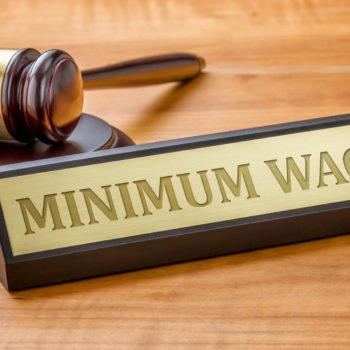Thin edge of the wage

In January of this year the minimum wage was increased by 50c. This brought it up to €9.15 an hour and the second highest minimum wage in Europe. Now the Low Pay Commission (LPC) is recommending another increase of 10c. Anne Brady looks at how the industry feels about this most recent cost
19 August 2016

The low pay technical group was set up to review Ireland’s minimum wage on an annual basis and make recommendations to the government based on a series of consultations and research analysis. The national minimum wage (NMW) will then be adjusted appropriately over a period of time. Any changes are made with the view to assist low-paid workers without causing adverse consequences to employment or competitiveness.
According to the Low Pay Commission, ‘Recommendations for the Minimum Wage Report’ released in July: “With inflation forecast at 0.4% for 2016, the proposed increase represents a small increase in the real value of the minimum wage. On foot of our recommendation the minimum wage recommended for 2017 will be in the order of 55.6% of the estimated hourly median earnings of full-time workers (NMW of €9.25 compared to an estimated median hourly rate for full-time employees of €16.63).” It is worth noting the Programme for Government contained a commitment to raise the minimum wage to €10.50 by 2021.
Rising cost base
Competitive pricing, higher operational costs, changing shopping habits, competition from bigger stores and discount stores are all challenges that the convenience sector has faced in recent times. But after a number of very difficult years convenience retail is seeing positive growth. Current economic markers are also the best they have been in a long while. Now should be the time to determine the impact of January’s wage increase before adding an additional 10c. Local, independent, family-run stores are imperative to the life of Irish towns and villages and as such should be supported and encouraged to grow and employ more staff. Not deterred.
According to Retail Ireland Director Thomas Burke, “there is absolutely no economic basis for a further minimum wage increase, following the 6% increase earlier this year. Any additional rise will put further pressure on thousands of retail businesses that are already grappling with intense competitive pressures and a rising cost base.”

Taoiseach Enda Kenny, Tanaiste Joan Burton and Ministers Richard Bruton and Ged Nash today launching the Low Pay Commission at St Andrew’s Resource Centre, Pearse St, Dublin 2, last year
‘Living wage’
Meanwhile many unions are calling on the government to raise the minimum wage to the living wage. This is €11.50 and one in five workers earns less than it. A report in the Irish Times, gathered from CSO and industry and trade union data, showed that in the retail and wholesale sector an estimated 29% of workers earn less than the living wage. This is compared to 54% in the accommodation and food sector or 7% in information and communication. The national minimum wage is not based on the cost of living whereas the living wage is evidence based and grounded in social consensus. Back in February, Minister for Business and Employment Ged Nash explained that it was not up to the government to enforce a living wage; that it should be up to “employers, workers and civil society.” The idea of having a living minimum wage is to ensure an acceptable standard of living and establish an hourly rate that provides employees with sufficient income to meet their basic needs.
According to NOffLA, “such an increase would place an impossible burden on many off-licence retailers all over the country, potentially leading to closure and job losses. In our 2016 Members Survey, 43% of respondents stated that they would reduce staff numbers by at least one if the minimum wage was increased to €10.50 per hour. It is important to remember that such increases generally have a knock-on impact whereby more senior or experienced members of staff have to receive increases also, thus increasing the actual cost to businesses. NOffLA members are committed to their staff, looking to reward excellence in alcohol retailing however any increase in the minimum wage must be sustainable.”
The recommendations made by the LPC in July cite a number of national and international research studies that show “the effect of a moderate incremental adjustment in the NMW is unlikely to be significantly adverse”. The research showed minimal or no impact. It also reported no significant change to prices or jobs but an improvement in job retention and productivity was seen.

Low Pay Commission family portrait: (front row, left to right) Director of PublicPolicy.ie Dr Donal de Buitleir, Minister for Jobs, Enterprise and Innovation Richard Bruton, An Taoiseach Enda Kenny, Tanaiste and Minister for Social Protection Joan Burton and Minister of State for Business and Employment Ged Nash, (back row, left to right) chief executive, Maxol Group Tom Noonan; director, Migrant Rights Centre, Edel McGinley; director, HR Suite, Caroline McEnery; economics lecturer, WIT Business School, Mary Mosse; professor of economics, NUI Maynooth, Donal O’Neill; CEO, CSNA, Vincent Jennings; Siptu’s Patricia King and Mandate’s Gerry Light
Implications for independent retailers
Wage inflation still remains a threat for many convenience stores. While stores that are well established or located in prime locations might not feel a negative impact, others are much more susceptible to increased costs. When retailers, like any business, are in a profitable position they then can increase staff wages. Additionally, high performing staff can receive monetary awards to boost motivation and productivity within the store. Convenience stores are the most significant employers in the retail sector, often paying above the national minimum wage. These family-owned shops give many people their first jobs and provide often essential part time and weekend employment to college going students. According to RGDATA there is no indication that the rates of pay for students or other cohorts of people are presenting any problems or challenges.
Tara Buckley, director general, RGDATA told ShelfLife: “The increase last January in the National Minimum Wage has had significant consequences for members’ stores. The majority of members say that it has led to pay claims from employees who are already earning in excess of the minimum wage. It has also had implications for consumers and staff – these wage increases have resulted in a decrease in the number of hours available to staff, a decrease in the number of staff employed and retailers say that they have had to increase prices of products to cover the additional costs.”
Between 2009 and 2013, 800 convenience stores closed down. The independent off-licence industry has lost 3,000 jobs since 2008. Shocking figures from the 2016 NOffLA members’ survey showed that 43% of respondents reported that the recent minimum wage increase had a negative impact on their business with 27% stating they were struggling to stay open as a result. Any further increase would exacerbate the difficulties being felt by small business retailers all over Ireland. The uncertainty of the Brexit vote still looms over retailers particularly in the border regions with the devalued Sterling making the return of cross border shopping a threat once again. Unsustainable increases are a threat to businesses. There is little point in introducing increases that ultimately lead to employees losing their jobs. Evelyn Jones, government affairs director, NOffLA said: “Our members are significant local employers based in communities all around the country and as such we have a clear view of the economic reality for Irish SMEs. While the economy is improving generally, as with previous years our Members Survey has shown that the recovery is not being felt by all.
Pressure on small retailers
An increase in disposable income from a higher wage floor is beneficial economically with more money for the exchequer and more money to be spent in shops around the country. However, this is yet another cost for retailers to contend with and many feel that the burden is being unfairly put on them. President of the CSNA Noel Kelly said: “Pressure continues to be put on small retailers. Although the proposed increase of 10c looks modest it has to be paid on holiday pay, bank holidays and across the board. For a small business with full and part time staff it all adds up. It’s another straw on the camel’s back. Of course retailers want to ensure that all their workers are looked after, we are conscious of our social responsibilities, but businesses are paying as much as they can afford. The government should be making a contribution in terms of PRSI which would immediately increase the amount of money in the pockets of lower paid workers.”
Arguments have been put forward regarding the necessity for government to address low pay issues through its tax policies and through social policies. Better childcare provisions, more supports for stay-at-home parents, improved rental and housing costs. These are just some areas that would result in more disposable income for families without the continuous pressure being put on businesses. Policies should be introduced to protect jobs and encourage investment in towns and villages. With legacy costs, utilities, rates and now a higher minimum wage, the figures keep adding up for Irish retailers. As one of the most important employers in the country they should not be taken for granted.
Retailers’ verdicts
RGDATA contacted members in relation to the recommendation the Low Pay Commission made to increase the minimum wage by another 10c
Independent retailer, Co. Louth:
“This is not helpful as we are still in challenging times. My staff are not back on full hours yet since I had to cut their hours during the recession. Any hike in wages is unsustainable.”
Supermarket owner, Co. Cavan:
“Yes any increase would impact on employment figures but lowering employers PRSI would help. The biggest worry for me at the moment is the Brexit issue regarding sterling/euro.”
Shop owner, Co. Louth:
“10c wouldn’t be a huge issue as a lot of independent retailers are paying more than the minimum rate. Lowering PRSI would definitely make a difference to employers. In my opinion the discounters are skewing the rates at the moment – they are paying more but forgetting their overheads are much less than the independent retailers. Brexit is a big concern and no change has shown up yet but it will be interesting to see will there be an impact when the schools reopen and it gets busier.”
Large supermarket owner, Co. Cork:
“A 10c increase would not make much difference but employers’ PRSI is a big issue so lowering it would be very welcome and would free up money to spend on employment. Increasing the minimum wage further would have a much bigger impact on me as I have 110 staff whereas discount food stores employ 12 – 15 staff so wouldn’t feel the impact as much. I would have to look at what’s viable or not for my shop and make changes as there would be a knock on effect should wages increase further.”



 Print
Print




Fans 0
Followers